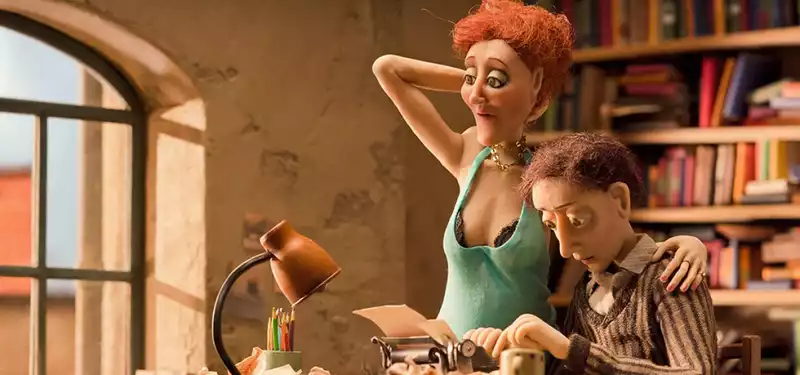Jan 19, 2017
Watch the online premiere of Spela Cades' festival hit "Boles"
Spera. adež's festival hit, the beautiful stop-motion short "Boles" (2013), makes its online debut today on Cartoon Brew.
Slovenian animation director Špela .adež debuted the 12-minute "Boles" nearly four years ago, winning nearly 50 festival awards and special recognition Boles, along with .adež's second animated short "Nighthawk" (2016), will debut today at Nighthawk was named one of the best animated shorts of last year in this recent industry survey.
Cartoon Brew met with .adež to talk balls, the joy of working with authentic material, the pointlessness of awards, and the dangers of getting lost in the details.
Cartoon Brew: Boles won many Grand Prix and Audience Awards during the festival rounds at the time, including Leipzig, Hiroshima, Anim'est, and Zagreb. To achieve such great success with his professional debut film...
Špela .adež: I feel like I was hated by animators all over the world. [The directors who had entered my film in the same festivals as mine said, "Oh, that film again. I think it's going to win another award, right? It's a little strange. Once you make a successful film, it's extremely difficult to make an even better film, especially if it's your debut film. Because people will judge you by what you've done before, and that definitely put a lot of pressure on me when I was making my second film, "Nighthawk."
You yourself have served on many juries and selection committees over the past few years. What have you learned from being on the "other side" -
Špela .adež: You have to wake up from the hundreds of films that the jury members have seen before your film. I also think that I am not so angry anymore when a film is not selected for the festival. Another thing I learned from being on the jury is that there is no such thing as the "best film," only the film that most closely matches the tastes of the person judging.
Do you feel that your success with "Balls" has made it easier to realize your next film? Winning awards means a lot, but at the same time it means very little. As an art student, I won a lot of awards, and I always thought they would help me finance my career and future filmmaking. But when I returned to Slovenia and applied for a grant, the foundation rejected the application. They replied that what I was doing was pointless and that I should stop. I realized then that no matter how many awards I won, it was meaningless, and that every time I applied for a grant, a new start, a new battle would begin.
When you make a new film, what makes you decide on the subject matter? I usually take something that has troubled me in my life and try to digest it through my work. I think that what is closest to me, what is inside me, is what makes the most honest film. As for Boles, I was looking for literature to base my short film on, and it was quite difficult to find something that resonated with me. But when I read Maxim Gorky's "Her Lover," I instantly knew it was "my" story.
What is your design process like? Do you design your characters on paper first, or do you sculpt them immediately? I do sketches first, but that is for fundraising purposes. But that's mostly because I have to do it for funding organizations. I like to get my fingers dirty and enjoy the material. It's really easy to express myself that way. [25] [26] For "Balls," I worked with a professional puppeteer (Jiga Lebar) to make silicone puppets from my initial designs. He is a real perfectionist. I used to improvise and create by myself, but this time he taught me how to create the design. I was very scared that I wouldn't be able to live up to the standards of the puppet artist. Everything he did was perfect in every detail."
Balls has a lot of visual detail. 2]
Spera. Adeju: Perhaps it is always determined by the time schedule. I have to complete a film project in two years, according to the strict laws of the Slovenian Ministry of Culture. I tend to get caught up in details, and I think this shows in "Balls. When I think about the main character, I want to think as much as possible about what his life, and by extension, his environment, is like. I remember being told in a storytelling class in college that everything you put in the background tells the viewer something about the character, so you don't need to explain them through the story. Maybe I took that too seriously. [laughs]
Your approach to animation has always focused on traditional and practical techniques. I don't dare to ask, but have you ever considered moving to digital? Traditional work can be tedious. Many colleagues have tried to convince me and I have considered it, but it just doesn't work the same way. My favorite part of traditional work is creating images under the camera, and the camera sees things very differently than we or the computer do. In my current short film, "Nighthawk," I put textures and smudged cells in front of the camera. It's an old trick. In old Hollywood movies, they used to put a piece of glass with Vaseline on it in front of the lens to give the actress a kind of glow.
I also have a magic pencil called an all-surface pencil. I use black and white pencils directly on the cell, and by adding water, I create lightness and darkness. Often I draw the final details on the spot. This series of hands-on experimentation is what I love about stop motion.
.



Post your comment